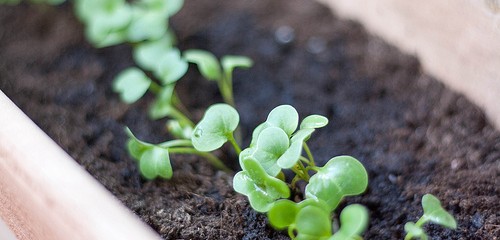Grow Your Own Herbs at Home

There’s no substitute for fresh cilantro in a bowl of homemade guacamole or just-plucked basil blended into a big batch of pesto. If you have to make an extra trip to the store for fresh herbs, though, chances are you’re just going to opt for the dried stuff you already have in your pantry.
There is a third option, though: always have fresh herbs on hand. You can accomplish this by creating your own herb garden at home. No matter how limited your space, you have enough room to cultivate fresh herbs at home if you follow these tips:
- Choose your containers. From classic terra cotta pots to stripped-down aluminum cans that used to hold beans or crushed tomatoes, your options for gardening containers are aplenty. If you’re on a budget, opt for the upcycled food cans (or mason jars) that you probably already have in the recycling bin. If you have some more cash to spare, buy some terra cotta pots at the garden store or Target—even these are pretty cheap.
- Start with easy herbs. If you’ve never gardened before, there are a few “starter” herbs that you might want to try before branching out into the harder stuff. Parsley, rosemary, and cilantro are among them.
- Consider your tastes. There’s no point in cultivating herbs that you aren’t going to use. Love a few sprigs of fresh mint in a glass of cool water? Do you crave the robust flavor of thyme in your stew? Then opt for growing these herbs. Even if you come across an herb that’s more difficult to cultivate than one you don’t love, it’s worth the extra work for something you’ll be plucking on a daily basis.
- Decide: seeds or seedlings? There’s something therapeutic about burrowing into rich soil with your own hands, sinking a few seeds into its depths, and then covering up the spot as if you’d never touched it. But there’s also a decent chance that, if you’re new to gardening, planted seeds won’t come up. There’s a lot working against them: the depth of the soil, the heat of the sun, the amount of moisture they can soak up. So if you’re not confident in your green thumb, start with seedlings that have already sprouted. You’ll simply have to transfer them from store-bought container to pot.
- Find a sunny spot. In general, herbs need between six and eight hours of sunshine per day. So whether you keep your herbs out on the deck or tucked into a window, just make sure that they’ll soak up as many rays as they need. The easiest way to set yourself up for herb garden failure is by not taking your plants’ need for sun seriously—and forgetting to water them often.
- Don’t skimp on the soil. Another common gardening blunder is using cheap, nutrient-poor soil for your garden. Even if you have to shell out some extra cash, opt for high-end, organic potting soil. Your plants will thank you—and you’ll probably rest easier knowing that your soil doesn’t contain any potentially harmful contaminants.
Image and attribution:
